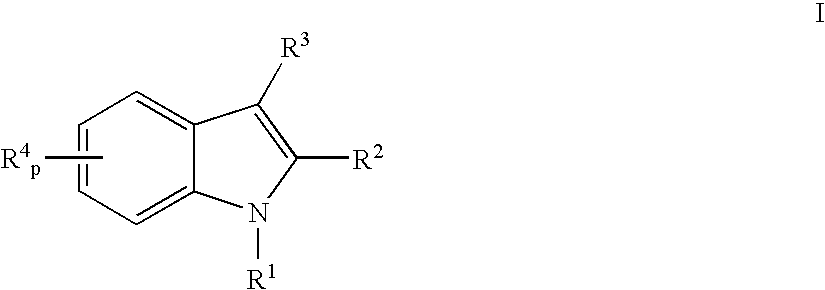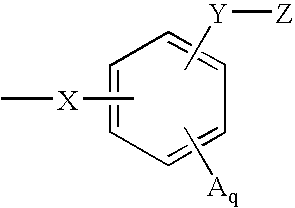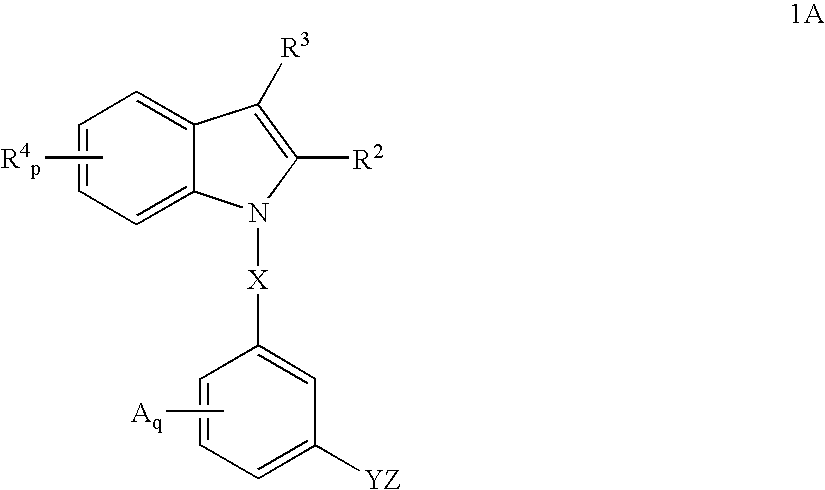Indoles having anti-diabetic activity
- Summary
- Abstract
- Description
- Claims
- Application Information
AI Technical Summary
Benefits of technology
Problems solved by technology
Method used
Image
Examples
example 1
[0242]
(2R)-2-{3-[3-(4-methoxy)benzoyl-2-methyl-6-(trifluoromethoxy)-1H-indol-1-yl]phenoxy}propanoic acid
[0243] Step 1:1-(3-methoxy)phenyl-2-methyl-6-trifluoromethoxyindole (1): 2-Methyl-6-trifluoromethoxyindole (645 mg, 3.0 mmole), 3-bromoanisole (0.456 ml, 3.6 mmole), sodium t-butoxide (404 mg, 4.2 mmole), trisdibenzylidine dipalladium (206 mg, 0.225 mmole) and 2-di-t-butylphosphinobiphenyl (201 mg, 0.675 mmole) were stirred in toluene at 80° C. and monitored by LC (3 / 1 hexanes / methylene chloride) or reversed phase HPLC until complete. The reaction mixture was then cooled, filtered over celite, and the filtrate evaporated to give a crude isolate, which was purified by silica gel chromatography to give the title compound.
[0244]1H NMR (500 MHz, CDCl3): δ 7.53 (d, Ph, 1H), 7.48 (t, Ph, 1H), 7.05 (dd, Ph, 1H), 7.02 (m, Ph, 2H), 6.95 (dd, ph, 1H), 6.89 (t, Ph, 1H), 6.42 (s, Ph, 1H), 3.88 (s, OCH3, 3H), 2.33 (s, 2-CH3, 3H).
[0245] Step 2: 1-(3-hydroxy)phenyl-2-methyl-6-trifluoromethoxy...
example 2
[0254]
(2S)-2-{3-[3-(4-methoxy)benzoyl-2-methyl-6-(trifluoromethoxy)-1H-indol-1-yl]phenoxyy}propanoic acid
[0255] This compound was made using a synthetic method analogous to Example 1 and using readily available reagents and starting materials. Such a synthesis can be readily carried out by a practitioner in the field of synthetic organic chemistry.
[0256]1H NMR (500 MHz, CDCl3): δ 7.87 (d, Ph, 2H), 7.54 (t, Ph, 1H), 7.45 (br s, Ph, 1H), 7.11 (br s, Ph, 1H), 7.02 (m, Ph, 411), 6.95 (m, Ph, 21), 4.88 (br m, OCH(CH3)CO2H, 1H), 3.93 (s, OCH3, 3H), 2.41 (s, 2-CH3, 3H), 1.74 (d, OCH(CH3)CO2H, 3H).
[0257] RP LC / MS: tR=3.88 min, m / e 514 (M+1)
Example 3
[0258]
example 3
[0259]
(2R)-2-{3-[3-(4-methoxy)benzopyl-2-methyl-6-(trifluoromethoxy)-1H-indol-1-yl]phenoxy}butanoic acid
[0260] Step 1:1-(3-methoxyphenyl-2-methyl-6-trifluoromethoxyindole (1): 2-Methyl-6-trifluoromethoxyindole (645 mg, 3.0 mmole), 3-bromoanisole (0.456 ml, 3.6 mmole), sodium t-butoxide (404 mg, 4.2 mmole), trisdibenzylidine dipalladium (206 mg, 0.225 mmole) and 2-di-t-butylphosphinobiphenyl (201 mg, 0.675 mmole) were stirred in toluene at 80° C. and monitored by TLC (3 / 1 hexanes / methylene chloride) or reversed phase HPLC until complete. The reaction mixture was then cooled, filtered over celite, and the filtrate evaporated to give a crude isolate, which was purified by silica gel chromatography to give the title compound.
[0261]1H NMR (500 MD, CDCl3): δ 7.53 (d, Ph, 1H), 7.48 (t, Ph, 1H), 7.05 (dd, Ph, 1H), 7.02 (m, Ph, 2H), 6.95 (dd, ph, 1H), 6.89 (t, Ph, 1H), 6.42 (s, Ph, 1H), 3.88 (s, OCH3, 3H), 2.33 (s, 2-CH3, 3H).
[0262] Step 2: 1-(3-hydroxy)phenyl-2-methyl-6-trifluoromethoxyi...
PUM
| Property | Measurement | Unit |
|---|---|---|
| Fraction | aaaaa | aaaaa |
| Current | aaaaa | aaaaa |
| Time | aaaaa | aaaaa |
Abstract
Description
Claims
Application Information
 Login to View More
Login to View More - R&D
- Intellectual Property
- Life Sciences
- Materials
- Tech Scout
- Unparalleled Data Quality
- Higher Quality Content
- 60% Fewer Hallucinations
Browse by: Latest US Patents, China's latest patents, Technical Efficacy Thesaurus, Application Domain, Technology Topic, Popular Technical Reports.
© 2025 PatSnap. All rights reserved.Legal|Privacy policy|Modern Slavery Act Transparency Statement|Sitemap|About US| Contact US: help@patsnap.com



